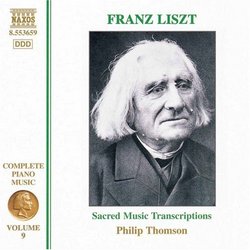| All Artists: Franz Liszt, Philip Thomson Title: Liszt: Sacred Music Transcriptions Members Wishing: 0 Total Copies: 0 Label: Naxos Release Date: 6/2/1998 Genre: Classical Styles: Opera & Classical Vocal, Forms & Genres, Short Forms, Sacred & Religious, Symphonies Number of Discs: 1 SwapaCD Credits: 1 UPC: 730099465922 |
Search - Franz Liszt, Philip Thomson :: Liszt: Sacred Music Transcriptions
 | Franz Liszt, Philip Thomson Liszt: Sacred Music Transcriptions Genre: Classical
|
Larger Image |
CD DetailsSimilar CDs
|
CD ReviewsLiszt - Religiosity through Minimalism Hexameron | 07/01/2006 (4 out of 5 stars) "Volume 9 of the Naxos Complete Piano Music of Liszt series is a special release. Most of the pieces here have only been recorded once before by the indefatigable Leslie Howard. The return of Philip Thomson, one of the greatest pianists showcased in this entire series, is also notable. I couldn't think of a better messenger to lend some quality to these mystical and unusual religious piano works. Liszt's sacred music is generally forgotten, but it exists as another great monument of Liszt's compositional scope. The pieces here exhibit startling diversity. Most are calm and introspective; others are majestic and sublime; and some are like hymns played on the piano. Liszt's "Hungarian Coronation Mass" was composed in honor of Franz Josef who became King of Hungary in 1867. This ceremonial choral work has been recorded before, but Liszt's two transcriptions are exquisite rarities. The 'Benedictus' is gentle but rapturous, while the 'Offertorium' exudes both quiet contemplation and ecstatic jubilance. "Urbi et orbi" (To the City and the World) is a powerful work quite alien to Liszt's aesthetic. While Liszt stamps his signature with dramatic religiosity and pianistic virtuosity, the expressive rhetoric of this through-composed music is unlike anything he's written. The Debussyan scintillating figurations that precede an eerie monophonic hymn played in pianissimo is just one example of this work's originality. "Ave maris stella" (Hail Star of the Sea) is a tranquil essay with occasional moments of understated intensity. "O Roma nobilis" and "Weihnachtslied" are all-too-brief with slight musical value. "Zum Haus des Herrn ziehen wir" (We Shall Go into the House of the Lord) is extrovert and Thomson pummels the massive fortissimo proclamation of chords with conviction. "In festo transfigurationis" is perhaps one of the finest gems on this recording, and shows Liszt forecasting minimalism. With scarce pianistic resources and within a few minutes, Liszt achieves a depth of profundity and musical substance incomparable to the previous works. I found the "Eleven Chorales" less than appealing, though their simplicity and serenity are captured remarkably well through Thomson's performance. The musically rich "Alleluja" is a whirling storm of majestic chords played with full-blooded passion by Thomson. The virtuosic excitement inherent in this piece makes it a worthy candidate for piano recitals. I believe the "Stabat Mater," however, is the greatest work featured here. Who could deny the profound emotional impact this work is capable of? The music alternates between loud unmerciful bass chords and soft pleading chords in the treble: there is obviously a program behind this. My own imagination creates the scenario of the bass chords representing Death, and the innocent and gentle response is the Soul (or life). There is a moving dialogue between the sinister character of Death and the despairing Soul. In an utterly transcendent moment, the Soul soars over the sorrow of Death through a gorgeous series of arpeggiated statements, bringing the work to a glorious end. Bottom line: I encourage others to experience the wealth of stirring moments in these reflective pieces. All of the music is agreeable, though some are too plain and boring. Despite the discrepancies of quality, Thomson's pianism and musicianship is in a league of its own; he is definitely the greater pianist to emerge from this Naxos series. The esoteric "Urbi et orbi," "In festo transfigurationis" and "Stabat Mater" are enough to make this recording worth owning." Ave "Liszt the Priest"! Sungu Okan | Istanbul, Istanbul Turkey | 06/05/2005 (5 out of 5 stars) "the complete list of works (because when I write that, these are not included on the page) "Two Pieces form Hungarian Coronation Mass" (S501/R192) (Benedictus and Offertorium) "Urbi et orbi" (S184/R69) "Ave maris stella" (S506/R195) "O Roma nobilis" (S546a) "Weihnachtslied" Christus ist geboren (S502/R197) "Zum Huas des Herrn ziehen wir" (In donum Domini ibimus) (S505/R178) "In festo transfigurationis domini nostri Jesu Christi (S188/R74) "L'hymne de pape" (S530/R190) "Stabat Mater" (without S number, after 1847) "Eleven Chorales" (S504b) (Arrangements of S50/R72, S51/R408, S61/R507) "Sancta Dorothea" (S187/R73) "Alleluja" (S183/R68a) This CD contains his most experimantal, mystic works. These works written at his last period, 1860-1886 and almostly at Rome. As you know, when he came to Rome with Carolyne Sayn-zu Witgennstein (his very close and religious friend but he was never married!), Liszt's character was changed. So, he was not play at the concerts at all, and he was not be Don Juan anymore! (as you know, when he was young, his lovers' list is very huge like a book!!) But, at Rome Liszt lived at Villa d'Este and he was meet with the priests, regularly. And at last, he wanted to be a priest! And he written usually religious works. These works are not completely tempestous and tumultuous, like his yuong-period-works. These are more calm, more mystic, more unexpectable works. Because Liszt was bored to write more virtuosic and fortissimo works! In this works, we exploring Liszt's mind and his more demonic, more meaningful works. And the performances of Philip Thomson are very good, he played the heavenly passages very soft and he is powerful at fortissimo passages too. I like especially: "Sancta Dorothea" (it's heavenly, it's smiling death!) "Urbi et Orbi" (benediction papale which comes at end) "In festo transfigurationis Domini nostri Jesu Christe" (apotheosis of Jesus) "L'hymne de pape" Highly recommended, especially for Liszt fans or to listen more interesting Liszt works." Liszt's Sacred Music Transcriptions Amy | 10/06/2007 (5 out of 5 stars) "A romantic, extrovert and musical genius were the parts that made Franz Liszt. But below his ever changing personality was a deeply religious person, who, particularly in his younger life had ideas of making his life in the church and becoming a priest. Another romantic quest took him to Rome in 1861, and he made his home there until he died in 1886 during a visit to see Wagner. It was during those last few years that the church eventually reclaimed him, and he took holy orders. This collection can be described as his Sacred Music Transcriptions. The first song on the cd, The Hungarian Coronation Mass Benedictus is my favorite Liszt composition of all time. The beginning starts very simple, but then in the middle it changes with a great climax and then slowly fades away. For me, this piece represents emotions evoked by the beauties of the world and life which God has bestowed upon us and the torturous thoughts of death that carry us into realms of the afterlife that afflict and sometimes console us all. Liszt always said he was simply just a scribe for God and when you hear this piece you believe that God could in fact speak to Liszt through music. The other extensive work on the disc is the Eleven Chorales, which are a reworking of sacred songs. They show the composer at his most devout and uncomplicated, the music being of the utmost simplicity. At the other end of the spectrum we have Urbi et orbi, a challenging work for the pianist, and a most unusual and radical score of many surprises. Apart from the l hymne du pape and the Stabat Mater, the remaining works all come from his later period when the church was increasingly taking over his mind. He was still in his theatrical period when he composed the virtuoutic Stabat Mater. This is a wonderful cd and I highly recommend it to any one who wants to hear Liszt's religious works."
|

 Track Listings (23) - Disc #1
Track Listings (23) - Disc #1

